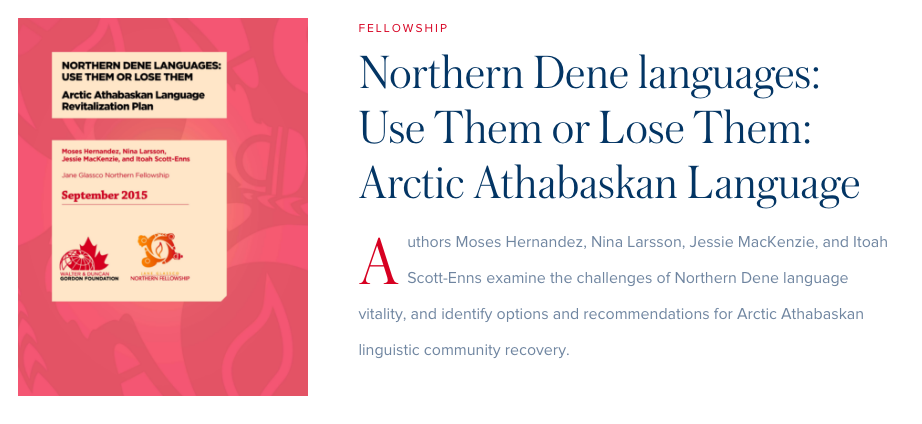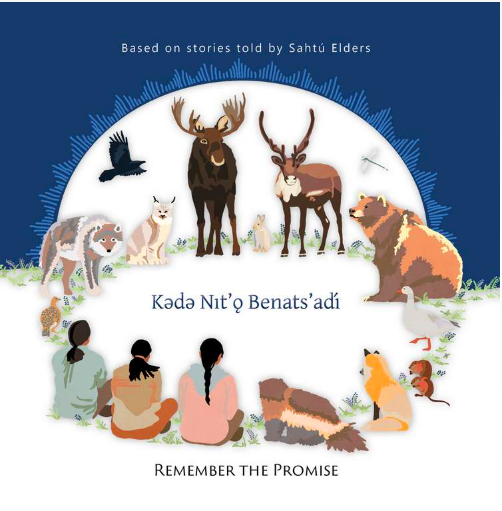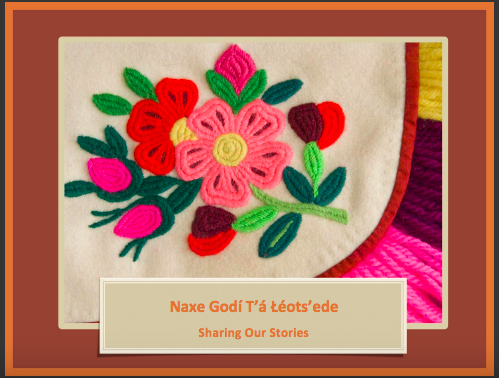Annual Report on Official Languages 2014-2015
Every fiscal year, the Government of the Northwest Territories issues a record of measures taken to implement the Official Languages Act. Each report details developments in both French and Aboriginal language programming. Many programs focus on connecting youth with elders, training teachers, developing curriculum, and providing government services in as many languages as possible.
Highlights from 2014-2015:
The Sahtu Dene Council organized numerous cultural and on-the-land programs, such as seasonal hunts, spiritual gatherings and culture camps. All of these provide opportunities for youth to learn from Elders about traditional knowledge and customs as well as learn their language. Dene Literacy Classes were conducted, as were regular language classes at all four schools in the region. The SDC also recorded and distributed 200 USB Drives (memory sticks) with Elders’ stories.
Access this Resource:
The Government of the Northwest Territories makes reports from the last decade available here: https://www.ece.gov.nt.ca/en/services/francophone-affairs-secretariat/official-languages-annual-reports
The 2014-2015 report PDF is available here: https://www.ece.gov.nt.ca/sites/ece/files/resources/official_languages_report_2014-15.pdf
Government of the Northwest Territories. Annual Report on Official Languages. Yellowknife: 2015.
Northern Dene Languages: Use them or lose them
This paper assesses the state of Northern Athabaskan languages internationally, and examines language policy at the federal, state/province, and regional/local levels. It notes Sahtú and NWT policy initiatives such as the regional and territorial strategic plans, but comments that a dearth of evaluation has made it difficult to assess the impacts of these initiatives. The authors present many alternative strategies to address the dangers of language loss, including the following.
For individuals, communities, and regions (p. 15)
1. Athabaskan families should make more use of Arctic Athabaskan languages at home;
2. Communities should create more Arctic Athabaskan language learning environments in which elders, children, and youth can interact;
3. Current and emerging leadership should increase their use of Arctic
Athabaskan languages in public settings as much as possible; and
4. First Nations governments and organizations could require greater use of Arctic Athabaskan languages in their operations.
For territories and states (p. 17)
1. Dedicate long-term funding for Arctic Athabaskan language programs for daycares and pre-schools;
2. Amend territorial and state curricula to make Arctic Athabaskan language proficiency a requirement for high school graduation;
3. Territorial and state governments should develop structures to support public sector employees’ Arctic Athabaskan language learning, through the use of instructors, course material, and leave with pay;
4. Require industry to negotiate the use of Arctic Athabaskan languages in appropriate workplaces.
For Canada and the United States (p. 20)
Write a “Dene Language Accord” that “supports Athabaskan language use as well as French and English.”

Access this Resource:
This paper is made available open access by the Gordon Foundation at this link: http://gordonfoundation.ca/resource/northern-dene-languages-use-them-or-lose-them-arctic-athabaskan-language/
Hernandez, Moses, Nina Larsson, Jessie MacKenzie, and Itoah Scott-Enns. Northern Dene Languages: Use them or lose them, Arctic Athabaskan Language Revitalization Plan. Toronto: Walter & Duncan Gordon Foundation, 2015.
Shutaot’ine Intro
The first version of Shutaot’ine Intro, an app for both Android and Apple, was released on May 11, 2012. The app offers vocabulary and phase options to begin with. They are: Food, Body, Words, Buildings, Actions, Conversations, More, Order, Time, Days, Months, Numbers, Money, Quantity, Animals, Colors, Commands, Dene, Family, TPR Vocab, TPR, Song, and Introductions. Within each category, options let you “learn,” or take a lesson, play “games” of different levels, or take “quizzes” in listening, speaking, and reading.
From App Description:
Danet’e! The Government of the Northwest Territories Department of Education, Culture and Employment, Yamozha Kue Society and the Sahtu Divisional Education Council are delighted to present a North Slavey language app available on the Google Play store. Shutaot’ine Intro offers language learning, practice, games and quizzes in many everyday categories such as food, actions, conversation, family and introductions. Learn your language and surprise your Elders! Mahsi cho.
Access this Resource:
To use this application, download it for free from one of the following links:
Google Play (Android devices): https://play.google.com/store/apps/details?id=com.languagepal.androidjessee_north_slavey&hl=en_GB
The App Store (Apple devices): https://itunes.apple.com/NZ/app/id524858939?mt=8
Yamózha Kúé Society, Northwest Territories Department of Education, Culture and Employment, and the Sahtú Divisional Education Council. Shutaot’ine Intro. Mobile Device Application. Version 1.1, December 15, 2015.
A Language Survey of Northern Métis Languages: A Community-Based Language Revitalization Project
Saunders’ research uses a Community-based language revitalization approach to discuss the languages practices and attitudes of Northern Métis language communities, in the region North of Slave Lake. Saunders worked closely with the North Slave Métis Alliance, and distributed a survey to Métis people in Yellowknife and Fort Providence. The author found that the language was a unique variety of French, but that language shift is taking place rapidly.
From Abstract:
The purpose of the thesis is two-fold: to document the results of a language survey of Northern Métis languages which examines the language practices and attitudes of those Northern Métis people who participated, and to reflect upon the research process by examining the assumptions I bring to the research and my role and the role of other Masters level researchers in language revitalization projects. The research presented here has been conducted within the Community-based language revitalization (CBLR) research model (Czaykowska-Higgins 2009), a model which can be a powerful way to frame linguistic research and which is increasingly called upon when undertaking language revitalization projects. This thesis addresses the application of CBLR practices to a language revitalization project undertaken in collaboration with the North Slave Métis Alliance in the Northwest Territories, Canada. Along with positioning myself in the research, I provide an in-depth description of the historical, political, and social landscape in which the research takes place. My epistemologies and the CBLR model are informed by feminist and Native American methodologies, as well as participatory, participatory-action and action frameworks. Through this lens, I reflect on the academic context of language revitalization and offer my own model of collaborative language research which builds upon work done by Leonard & Haynes (2010). Applying this model, I present the results of the North Slave Métis Language Survey, conducted in 2013 in collaboration with the North Slave Métis Alliance. This thesis contributes to the body of work on Métis languages, and is the first to thoroughly examine and document the language practices of Métis people of the NWT. It also contributes to the growing body of work on CBLR research.
Read other University of Victoria Language Revitalization MA Theses from Laura Tutcho and Fibbie Tatti.
Access this Resource:
This thesis has been made available for free by the University of Victoria at this link: http://hdl.handle.net/1828/6152
Saunders, Susan Jane. A Language Survey of Northern Métis Languages: A Community-Based Language Revitalization Project. Master’s Thesis, University of Victoria, 2015.
The Wind Waits For No One: Nı̨hts’ı Dene Ası̨́ Henáoréhɂı̨́le Ǫt’e: Spirituality in a Sahtúgot’ı̨nę Perspective
Fibbie Tatti’s thesis explores Sahtúgot’ı̨nę spirituality: it describes and defines spirituality “from the perspective of the Sahtúgot’ı̨nę, distinguishing spirituality from concepts such as worldview, culture, and medicine power” (iii, abstract). Spirituality is an essential component of Dene education, Tatti writes. In documents like the Dene Kedǝ curriculum (1993) inclusion of spirituality (which makes up one quarter of the curriculum, along with relationships with land, people, and self) is important but difficult, because spirituality is different for different Indigenous peoples, and means different things.
Teaching on the land, for the Sahtúgot’ı̨nę, is paired with ceremony: feeding the fire, for example. Ceremonies are still practiced but gradually less understood, in part due to language loss. Each ceremony must be contextualized by history an, and the Elders explain this in a language that fewer and fewer youth can understand. Tatti also emphasizes the distinctions between worldview, culture, and spirituality, emphasizing a dependent relationship with animals and the cosmos—this fundamental relationship guides Dene behaviour, laws, and epistemology.
From Abstract:
The Sahtúgot’ı̨nę have lived in the Sahtú Region around Great Bear Lake since time immemorial. Our Elders believe that spirituality is the foundation for our language, culture and worldview and that it is essential for our language and culture to be taught in the context of spirituality. This thesis provides a description and a definition of spirituality from the perspective of the Sahtúgot’ı̨nę, distinguishing spirituality from concepts such as worldview, culture and medicine power. In keeping with our traditional ways of preserving and transmitting knowledge to future generations, the paper relies heavily on stories passed on to us from our Elders. The paper elaborates on key concepts of Sahtúgot’ı̨nę spirituality. First, like human beings, all animals on this earth have a living spirit or bets’ı̨nę́. Other entities on this earth - plants and trees, the water and the wind - are also living beings with their own yǝ́dı́ı. Specific geographic sites with a special significance to the Sahtúgot’ı̨nę are also said to be yǝ́dı́ı. The other key concept is the existence of three dimensions of existence and their inter-relationship which is crucial to the understanding of Sahtúgot’ı̨nę spirituality.
Read other University of Victoria Language Revitalization MA Theses from Susan Saunders and Laura Tutcho.
Access this Resource:
The University of Victoria has made this thesis available for free here: http://hdl.handle.net/1828/6113
Tatti, Fibbie. The Wind Waits For No One: Nı̨hts’ı Dene Ası̨ ́ Henáoréhɂı̨ ́le Ǫt’e: Spirituality in a Sahtúgot’ı̨nę Perspective. Master’s Thesis, University of Victoria, 2015.
Annual Report on Official Languages 2013-2014
Every fiscal year, the Government of the Northwest Territories issues a record of measures taken to implement the Official Languages Act. Each report details developments in both French and Aboriginal language programming. Many programs focus on connecting youth with elders, training teachers, developing curriculum, and providing government services in as many languages as possible.
Highlights from 2013-2014:
Three Sahtú Communities had language nests (Délįne, Tulíta and Fort Good Hope). Teaching and Learning Centres continued (from previous years) to develop Dene Kedǝ curriculum implementation guides. An important legislative change was enacted: “Members of the Legislative Assembly may use any of the Aboriginal languages in the debates and other proceedings of the Assembly. This services is also extended to the members of the Youth Parliament and the Elders Parliament” (15). The Sahtú Dene Council distributed a dictionary for language learning in Fort Good Hope, and "offered cultural activities within the Sahtú region between the youth and Elders by practicing speaking through on the land activities.”
Access this Resource:
The Government of the Northwest Territories makes reports from the last decade available here: https://www.ece.gov.nt.ca/en/services/francophone-affairs-secretariat/official-languages-annual-reports
The 2013-2014 PDF is available here: https://www.ece.gov.nt.ca/sites/ece/files/resources/official_languages_report_2013-14.pdf
Government of the Northwest Territories. Annual Report on Official Languages. Yellowknife: 2014.
Aboriginal languages and selected vitality indicators in 2011
This paper examines language vitality in Canada using the 2011 Census and National Household Survey data on mother tongue and conversational second language use. The Census of Population groups Aboriginal Languages into 12 families: Dene was measured as having 11,860 mother tongue speakers in 2011, lower than Cree (83,000) but higher than many others including Stoney, Blackfoot, and Innu. In addition, 67.9% of mother tongue Dene speakers reported using Dene most often at home, with a further 21.1% using it regularly in the home. Across Canada, people were more likely to speak their Aboriginal Language at home when they lived in a community (or census subdivision) where a high proportion of people shared that language. They were less likely to use it regularly if they moved to an area where most people had a different mother tongue, such as English or French. Between all Inuit, Métis, and First Nations communities in Canada in 2011, 21.7% of those able to conduct a conversation in an Aboriginal Language had acquired it as a second language.
Access this Resource:
Read the full text for free from Statistics Canada online.
Langlois, Stéphanie and Annie Turner. “Aboriginal Languages and Selected Vitality Indicators in 2011.” Statistics Canada Catalogue no. 89-655 (2014).
Kǝdǝ Nıt’ǫ Benats’ adı́ - Xǝdǝ Rı́hęt’ǫ Herats’ǝ́dı (Remember the Promise)
From Introduction: "In March 2013, elders, Dene language specialists and others got together for a workshop to talk about how the story of species at risk can be understood through the language and stories of Dene and Métis. They agreed that the main people who need to work on these things are the present and future youth of the Sahtú Region. This book is dedicated to the workshop participants, and to the youth who are the future stewards of the land.
The first part of this book is a story, Remember the Promise, with Dene words. The meanings of those words can be found in the glossary (page 18). The second part includes more details about the workshop and the terms that were worked on in the dialects of Délı̨nę, Tulı́t’a, and K’asho Got’ı̨nę. The last part has more information about species at risk in the NWT.
Keeping the Dene language alive is part of keeping alive people’s sacred and respectful relationships with other living things. We hope that this book will encourage people to speak and understand the language of this land, the language of the ancestors. Through the language, we are sure to remember the promise."
Read more about this project, and access the full text in multiple languages, on the Remember the Promise page on the SRRB site.
Sahtú Renewable Resources Board. Kǝdǝ Nıt’ǫ Benats’adı́, Remember the Promise. Compiled by Betty Harnum and Deborah Simmons, with a foreword by Michael Neyelle, 2014.
Naxe Godı́ T’á Łéots’ede, Sharing our Stories
This document is a public collections record featuring stories and photographs of objects from the Sahtú region. It was developed between 2013 and January 2014 by the Prince of Wales Northern Heritage Centre (PWNHC) and:
Elders: Maurice Mendo, Camilla Tutcho, and Vicki Orlias
Interpreter: Lucy Ann Yakelaya
Students: Dalton Takazo, Darren Horassi, Carmen McNeely, and Chantelle Orlias
Chaperones: Jessie Campbell and Richard Andrew
Sponsors: The PWNHC and Education, Culture, and Employment (GNWT)
Workshop Coordinator: Wendy Stephenson
Naxe Godı́ T’á Łéots’ede, Sharing our Stories documents a workshop wherein Elders, Students, and other Sahtú region participants gathered to give oral histories to objects in the Prince of Wales Northern Heritage Centre (PWNHC) collection. Objects such as mukluks were identified in as many different Sahtú dialects as possible, Délı̨nę, Tulı́t’a, and Fort Good Hope. Students listened to elders talk about their purpose and history, and Elder’s quotations were preserved by the PWNHC in this record.
Access this Resource:
The PWNHC has the full text of this book and other language communities' projects on their website: https://www.pwnhc.ca/collections/sharing-our-stories/
Prince of Wales Northern Heritage Centre and Sahtú Dene Elders. Naxe Godı́ T’á Łéots’ede, Sharing our Stories. Yellowknife, 2014.
From the ground up
This short paper provides an overview of Yukon, NWT, and Nunavut literacy non-profit organizations and coalitions. In general, these organizations attempt to work collectively, with families, communities, and intergenerational groups. Literacy programs depend on an interested party in the community working as a liaison, and usually are integrated into existing programming at libraries, early childhood programs, with health and recreation activities, or in other settings.
Abstract:
Community-based family literacy programmes tend to be neglected in a policy environment that ties funding for literacy programmes to work outcomes. In these circumstances many communities tackle their own local challenges, and the literacy coalitions in northern Canada are good examples of local communities taking a lead. Aggie Brockman discusses how they do it.
Access this Resource:
This resource is not publically available, but can be purchased from Fine Print.
Brockman, Aggie. “From the Ground Up.” Fine Print 36, no. 3 (2013): 8-11.




 Phone: 867-374-4040
Phone: 867-374-4040 Email:
Email: